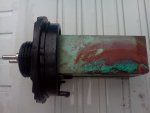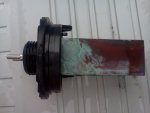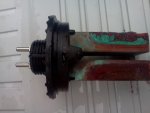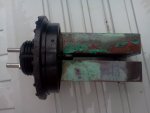In order to not hijack this thread, I thought I would bring this idea of using the Intex swg copper bars as a waterbond to seperate/new thread.
I was reminded of it when Ohm_Boy mentioned:
Originally I took my copper electrode bars out of the intex swg, but then I had the idea of using them as the waterbond. I put my bars back onto the intex swg but did not hook them up...just observed them over time.
The copper bars have a total surface area of ~12 in^2 (assuming you attach to both of them) so that should meet the minimum 9 in^2 in NEC 680.26. However, somewhere I have read that the conductor needed to be corrosion resistant such as stainless steel or aluminum. My copper bars appeared oxidized (were not bright copper if I remember) when I bought the swg and then over time in contact with the pool water get that green/blue covering in some places which I have read is copper carbonate, copper chloride and/or copper sulphide. All of this does not seem to lead to corrosion in the classical sense, but I wonder if it meets the requirements.
I have probed between the SS (I think) connections and the bars with my RS ohmmeter. There are a number of different looking surfaces I find on the bars, some having ~ 1 Mohm resistance and some having ~1 ohm resistance. The green/blue surfaces seem to have a resistance in the ~ 500 ohm range until you break through it (it seem to be almost a flake above the surface). In the end, I wonder if this meets the functional requirements of the getting a good bond.
I also wonder if there is a small potential on them due to equipotential, if that might cause "corrosion" or loss of copper.
Here are some pics of my electrodes:
[attachment=0:1soo0ks7]IMG_20120526_171448.jpg[/attachment:1soo0ks7][attachment=1:1soo0ks7]IMG_20120526_171446.jpg[/attachment:1soo0ks7][attachment=2:1soo0ks7]IMG_20120526_171441.jpg[/attachment:1soo0ks7][attachment=3:1soo0ks7]IMG_20120526_171439.jpg[/attachment:1soo0ks7]
Any thoughts?
I was reminded of it when Ohm_Boy mentioned:
Ohm_Boy said:If you had and passed a bonding inspection, then maybe, just maybe there is a bonding loop around your pool, and you may just need to bond the water. There should be something conductive with at least 9 sq in. of surface in contact with the water and connected to the bonding grid. If you don't have this, then even if the perimiter of your pool were bonded there could still be a problem relative to the water.
There are special (read: expensive) stainless steel pipe fittings with binding posts to which a bond wire can be connected, and some folks have made up "water bond" fittings by coiling up 9 sq. in. equivalance of #8 copper wire inside PVC pipe and through a hole in the pipe, which is sealed, and connected to the grid. Maybe you could just insert a section of copper pipe in your plumbing and bond it using a grounding clamp to attach a bonding wire.
Originally I took my copper electrode bars out of the intex swg, but then I had the idea of using them as the waterbond. I put my bars back onto the intex swg but did not hook them up...just observed them over time.
The copper bars have a total surface area of ~12 in^2 (assuming you attach to both of them) so that should meet the minimum 9 in^2 in NEC 680.26. However, somewhere I have read that the conductor needed to be corrosion resistant such as stainless steel or aluminum. My copper bars appeared oxidized (were not bright copper if I remember) when I bought the swg and then over time in contact with the pool water get that green/blue covering in some places which I have read is copper carbonate, copper chloride and/or copper sulphide. All of this does not seem to lead to corrosion in the classical sense, but I wonder if it meets the requirements.
I have probed between the SS (I think) connections and the bars with my RS ohmmeter. There are a number of different looking surfaces I find on the bars, some having ~ 1 Mohm resistance and some having ~1 ohm resistance. The green/blue surfaces seem to have a resistance in the ~ 500 ohm range until you break through it (it seem to be almost a flake above the surface). In the end, I wonder if this meets the functional requirements of the getting a good bond.
I also wonder if there is a small potential on them due to equipotential, if that might cause "corrosion" or loss of copper.
Here are some pics of my electrodes:
[attachment=0:1soo0ks7]IMG_20120526_171448.jpg[/attachment:1soo0ks7][attachment=1:1soo0ks7]IMG_20120526_171446.jpg[/attachment:1soo0ks7][attachment=2:1soo0ks7]IMG_20120526_171441.jpg[/attachment:1soo0ks7][attachment=3:1soo0ks7]IMG_20120526_171439.jpg[/attachment:1soo0ks7]
Any thoughts?





